欧盟的历史与发展【英文】
- 格式:ppt
- 大小:433.00 KB
- 文档页数:20

欧盟的发展历程欧盟(European Union)是由欧洲多个国家所组成的政治和经济联盟。
它的前身可以追溯到1951年的欧洲煤钢共同体(European Coal and Steel Community),而现在的欧盟则成立于1993年颁布的《马斯特里赫特条约》(Treaty of Maastricht)。
以下是欧盟的发展历程。
起初,欧洲国家为了避免再次爆发战争,决定共同合作。
1951年,法国、德国、意大利、比利时、卢森堡和荷兰六国签署了《巴黎条约》,建立了欧洲煤钢共同体。
该组织的目标是整合这些国家的煤炭和钢铁行业,以创造一个共同的市场并促进和平与繁荣。
在煤钢共同体的成功下,这六个国家决定进一步扩展合作领域。
1957年,签署了《罗马条约》,创建了欧洲经济共同体(EEC)和欧洲原子能共同体(EURATOM)。
EEC的目标是实现一个共同的市场,自由流通的货物、服务、资本和劳动力,推动经济的增长和就业的增加。
在接下来的几十年中,欧洲共同体逐渐扩大。
1973年丹麦、爱尔兰和英国加入,1980年希腊加入,1986年葡萄牙和西班牙加入。
这些新成员国的加入带来了欧洲共同体的进一步发展和多样性。
1993年,签署了《马斯特里赫特条约》,建立了欧洲联盟(European Union)。
欧洲联盟的目标是建立一个政治和经济一体化的欧洲。
其中最重要的要素是共同货币的引入。
1999年,欧元正式成为欧洲联盟的货币,这也是一个重要的里程碑。
21世纪以来,欧盟继续扩大。
2004年,捷克、爱沙尼亚、拉脱维亚、立陶宛、匈牙利、波兰、斯洛伐克、斯洛文尼亚和马耳他加入欧盟。
2007年罗马尼亚和保加利亚加入,2013年克罗地亚加入。
这些新成员国的加入进一步拓宽了欧洲联盟的范围。
然而,欧盟也面临了一些挑战和困难。
全球金融危机和欧债危机对欧洲经济造成了严重冲击。
同时,难民危机和恐怖主义的威胁也使欧盟面临压力。
这些问题的处理需要各成员国间更紧密的合作和协调。

欧盟的成立与发展历程回顾欧盟(European Union)作为一个拥有28个成员国的政治经济联盟,是世界上最重要的国际组织之一。
它的形成与发展历程是一个漫长而又复杂的过程。
本文将回顾欧盟从诞生到发展的历程。
第一章:欧洲经济一体化的初衷1.1 背景与动机20世纪初,欧洲国家间频繁爆发战争,战争造成的人员和经济损失惨重。
一战与二战之后,欧洲国家普遍意识到通过经济一体化与合作,可以避免战争的发生。
欧洲经济一体化的初衷正是来源于此。
1.2 欧洲煤钢共同体的建立1951年,六个国家(比利时、法国、德国、意大利、卢森堡和荷兰)签署了《巴黎协定》,建立了欧洲煤钢共同体(ECSC),这标志着欧洲一体化进程的开始。
ECSC的目标是在煤炭和钢铁生产与贸易上实现共同管制,从而促进经济一体化。
第二章:欧洲经济共同体的诞生2.1 罗马条约的签署1957年,六个国家签署了《罗马条约》,建立了欧洲经济共同体(EEC)和欧洲原子能共同体(EURATOM)。
EEC的目标是实现成员国间的经济一体化和自由贸易,为欧洲的和平与繁荣做出贡献。
2.2 跨国公司的兴起随着EEC的建立,欧洲市场逐渐壮大,吸引了越来越多的跨国公司进入。
这些跨国公司在欧洲不同国家之间进行工业生产和贸易,促进了欧洲国家间的经济联系和合作。
第三章:欧洲联盟的形成与发展3.1 单一欧洲法案的通过1986年,欧洲共同市场得到了扩大和完善,通过了单一欧洲法案。
单一欧洲法案的目标是消除成员国之间的贸易壁垒、促进资本、人员和服务的自由流动,并优化欧洲市场。
3.2 欧洲联盟的诞生1992年,欧洲共同体通过了《马斯特里赫特条约》,正式将其更名为欧洲联盟。
欧洲联盟的目标不仅仅是经济一体化,还包括共同外交与安全政策、司法与内政合作等领域。
第四章:欧洲联盟的扩大与深化4.1 扩大至东欧国家2004年至2007年,欧盟历史上最大规模的扩张发生,共有10个东欧国家加入欧盟。
这一扩大使欧盟的经济体量和政治影响力进一步增强,也加大了欧盟内部协调和合作的复杂性。
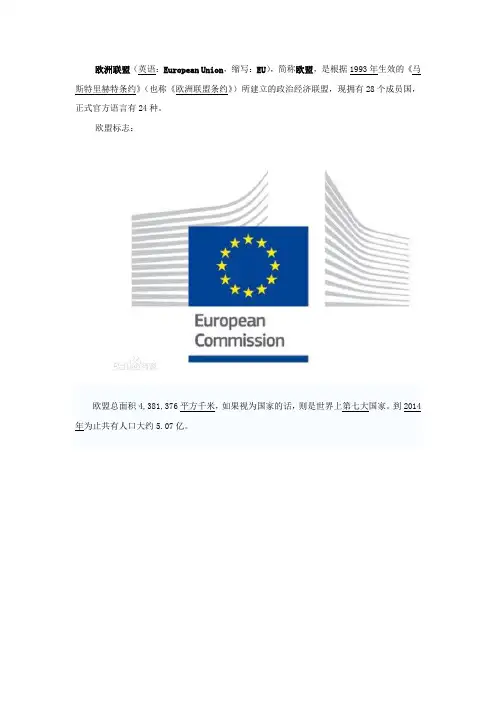

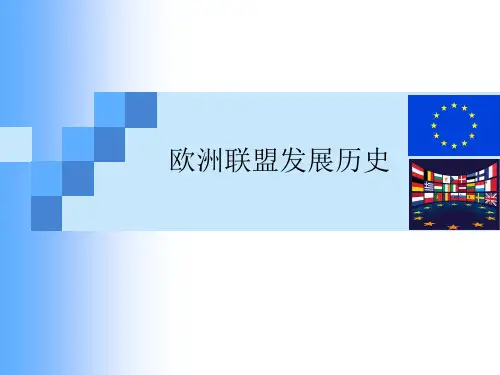
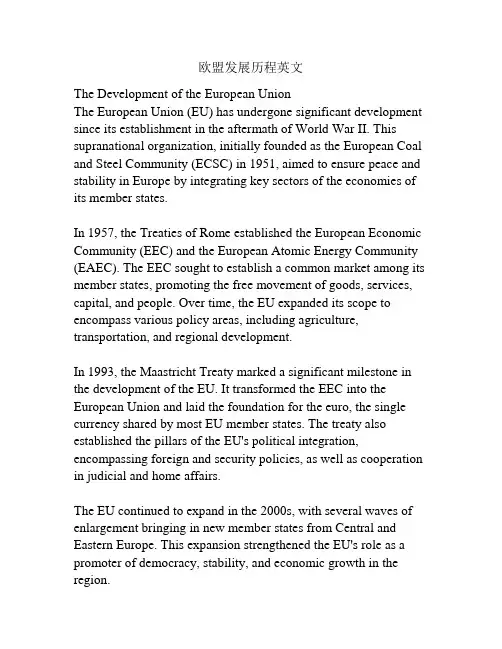
欧盟发展历程英文The Development of the European UnionThe European Union (EU) has undergone significant development since its establishment in the aftermath of World War II. This supranational organization, initially founded as the European Coal and Steel Community (ECSC) in 1951, aimed to ensure peace and stability in Europe by integrating key sectors of the economies of its member states.In 1957, the Treaties of Rome established the European Economic Community (EEC) and the European Atomic Energy Community (EAEC). The EEC sought to establish a common market among its member states, promoting the free movement of goods, services, capital, and people. Over time, the EU expanded its scope to encompass various policy areas, including agriculture, transportation, and regional development.In 1993, the Maastricht Treaty marked a significant milestone in the development of the EU. It transformed the EEC into the European Union and laid the foundation for the euro, the single currency shared by most EU member states. The treaty also established the pillars of the EU's political integration, encompassing foreign and security policies, as well as cooperation in judicial and home affairs.The EU continued to expand in the 2000s, with several waves of enlargement bringing in new member states from Central and Eastern Europe. This expansion strengthened the EU's role as a promoter of democracy, stability, and economic growth in the region.The EU has also faced various challenges throughout its development. Economic crises, such as the eurozone debt crisis in 2008, tested the resilience of the common currency and required collective efforts to stabilize the European economy. The EU has also grappled with issues of democratic legitimacy and decision-making, as well as managing the tensions between member states with differing national interests.In recent years, the EU has been focused on addressing global challenges, including climate change, migration, and cybersecurity. It has played a vital role in negotiating international agreements, such as the Paris Agreement on climate change, and in shaping global norms and standards.Overall, the development of the EU has been characterized by a gradual deepening of integration and cooperation among its member states. It has evolved from an organization primarily focused on economic cooperation to one with a broader mandate, encompassing political, legal, and social integration. Despite the challenges it faces, the EU continues to play a crucial role in maintaining peace, promoting prosperity, and protecting the values of its member states.。
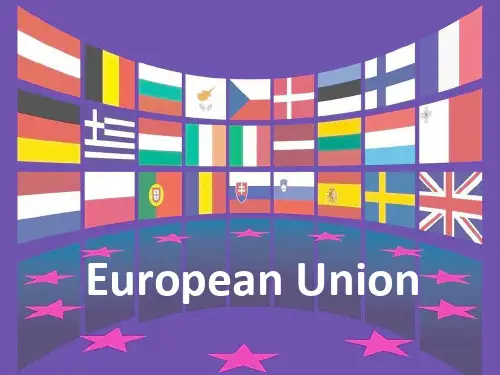
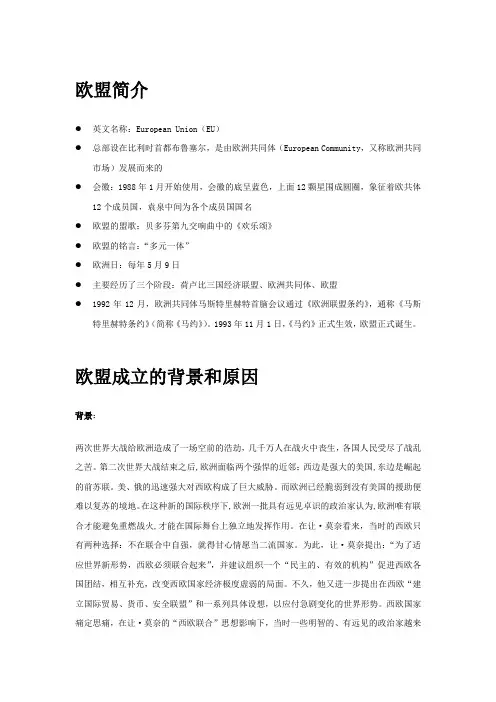
欧盟简介●英文名称:European Union(EU)●总部设在比利时首都布鲁塞尔,是由欧洲共同体(European Community,又称欧洲共同市场)发展而来的●会徽:1988年1月开始使用,会徽的底呈蓝色,上面12颗星围成圆圈,象征着欧共体12个成员国,袁泉中间为各个成员国国名●欧盟的盟歌:贝多芬第九交响曲中的《欢乐颂》●欧盟的铭言:“多元一体”●欧洲日:每年5月9日●主要经历了三个阶段:荷卢比三国经济联盟、欧洲共同体、欧盟●1992年12月,欧洲共同体马斯特里赫特首脑会议通过《欧洲联盟条约》,通称《马斯特里赫特条约》(简称《马约》)。
1993年11月1日,《马约》正式生效,欧盟正式诞生。
欧盟成立的背景和原因背景:两次世界大战给欧洲造成了一场空前的浩劫,几千万人在战火中丧生,各国人民受尽了战乱之苦。
第二次世界大战结束之后,欧洲面临两个强悍的近邻:西边是强大的美国,东边是崛起的前苏联。
美、俄的迅速强大对西欧构成了巨大威胁。
而欧洲已经脆弱到没有美国的援助便难以复苏的境地。
在这种新的国际秩序下,欧洲一批具有远见卓识的政治家认为,欧洲唯有联合才能避免重燃战火,才能在国际舞台上独立地发挥作用。
在让·莫奈看来,当时的西欧只有两种选择:不在联合中自强,就得甘心情愿当二流国家。
为此,让·莫奈提出:“为了适应世界新形势,西欧必须联合起来”,并建议组织一个“民主的、有效的机构”促进西欧各国团结,相互补充,改变西欧国家经济极度虚弱的局面。
不久,他又进一步提出在西欧“建立国际贸易、货币、安全联盟”和一系列具体设想,以应付急剧变化的世界形势。
西欧国家痛定思痛,在让·莫奈的“西欧联合”思想影响下,当时一些明智的、有远见的政治家越来越意识到西欧联合自强的重大战略意义。
原因:第一,欧洲认识到自身所处的不利地位。
战后的欧洲不再是世界舞台的主角,其位置被美国与苏联代替。
与这两个超级大国相比,欧洲是一个在军事上、政治上、经济上分割的小国集合。
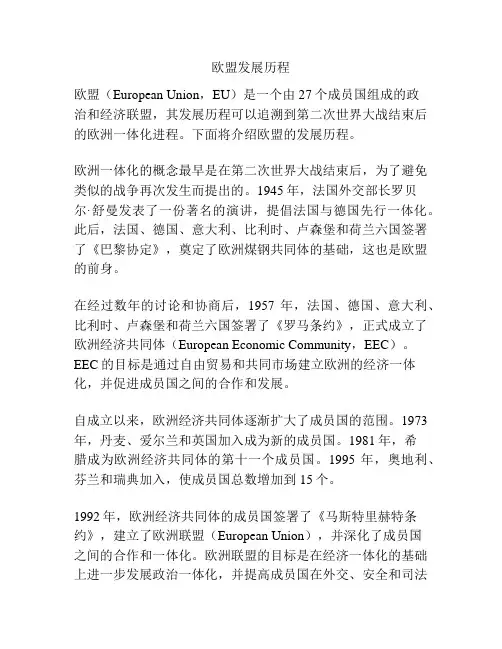
欧盟发展历程欧盟(European Union,EU)是一个由27个成员国组成的政治和经济联盟,其发展历程可以追溯到第二次世界大战结束后的欧洲一体化进程。
下面将介绍欧盟的发展历程。
欧洲一体化的概念最早是在第二次世界大战结束后,为了避免类似的战争再次发生而提出的。
1945年,法国外交部长罗贝尔·舒曼发表了一份著名的演讲,提倡法国与德国先行一体化。
此后,法国、德国、意大利、比利时、卢森堡和荷兰六国签署了《巴黎协定》,奠定了欧洲煤钢共同体的基础,这也是欧盟的前身。
在经过数年的讨论和协商后,1957年,法国、德国、意大利、比利时、卢森堡和荷兰六国签署了《罗马条约》,正式成立了欧洲经济共同体(European Economic Community,EEC)。
EEC的目标是通过自由贸易和共同市场建立欧洲的经济一体化,并促进成员国之间的合作和发展。
自成立以来,欧洲经济共同体逐渐扩大了成员国的范围。
1973年,丹麦、爱尔兰和英国加入成为新的成员国。
1981年,希腊成为欧洲经济共同体的第十一个成员国。
1995年,奥地利、芬兰和瑞典加入,使成员国总数增加到15个。
1992年,欧洲经济共同体的成员国签署了《马斯特里赫特条约》,建立了欧洲联盟(European Union),并深化了成员国之间的合作和一体化。
欧洲联盟的目标是在经济一体化的基础上进一步发展政治一体化,并提高成员国在外交、安全和司法等领域的合作。
2004年,欧洲联盟迎来了规模最大的扩大。
10个中欧和东欧国家(波兰、匈牙利、捷克、斯洛伐克、斯洛文尼亚、爱沙尼亚、拉脱维亚、立陶宛、塞浦路斯和马耳他)加入了欧洲联盟,使成员国总数增加到25个。
2007年,保加利亚和罗马尼亚成为欧洲联盟的成员国,使成员国总数增加到27个。
同时,克罗地亚于2013年加入,使成员国总数增加到28个。
然而,在英国的脱欧公投后,英国于2020年正式脱离欧洲联盟。
除了扩大成员国的范围,欧洲联盟还在推进一体化进程和制定共同政策方面取得了重要成就。
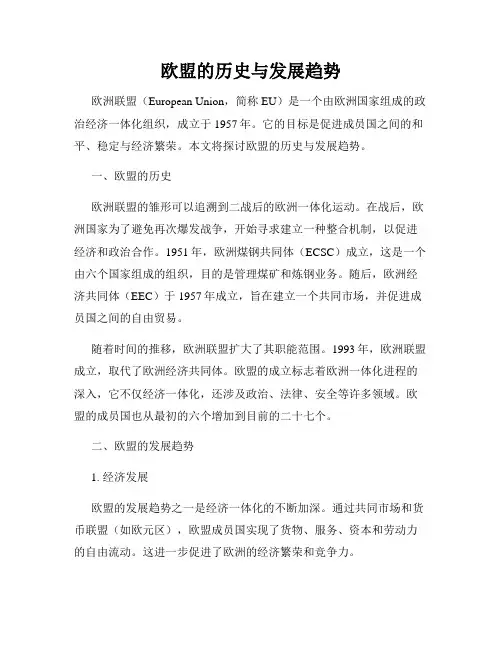
欧盟的历史与发展趋势欧洲联盟(European Union,简称EU)是一个由欧洲国家组成的政治经济一体化组织,成立于1957年。
它的目标是促进成员国之间的和平、稳定与经济繁荣。
本文将探讨欧盟的历史与发展趋势。
一、欧盟的历史欧洲联盟的雏形可以追溯到二战后的欧洲一体化运动。
在战后,欧洲国家为了避免再次爆发战争,开始寻求建立一种整合机制,以促进经济和政治合作。
1951年,欧洲煤钢共同体(ECSC)成立,这是一个由六个国家组成的组织,目的是管理煤矿和炼钢业务。
随后,欧洲经济共同体(EEC)于1957年成立,旨在建立一个共同市场,并促进成员国之间的自由贸易。
随着时间的推移,欧洲联盟扩大了其职能范围。
1993年,欧洲联盟成立,取代了欧洲经济共同体。
欧盟的成立标志着欧洲一体化进程的深入,它不仅经济一体化,还涉及政治、法律、安全等许多领域。
欧盟的成员国也从最初的六个增加到目前的二十七个。
二、欧盟的发展趋势1. 经济发展欧盟的发展趋势之一是经济一体化的不断加深。
通过共同市场和货币联盟(如欧元区),欧盟成员国实现了货物、服务、资本和劳动力的自由流动。
这进一步促进了欧洲的经济繁荣和竞争力。
2. 政治一体化欧盟的另一个发展趋势是政治一体化的推进。
欧盟建立了许多机构和组织,如欧洲委员会、欧洲议会和欧洲法院,以决策、监督和执行欧盟的政策。
通过共同制定法律和政策,欧盟成员国致力于实现共同的政治目标。
3. 扩大成员国欧盟的发展还包括扩大成员国的过程。
自成立以来,欧盟新加入了多个成员国,包括中东欧国家和斯堪的纳维亚国家。
这不仅为这些国家带来了经济和政治上的好处,也进一步加强了欧盟在全球事务中的地位和影响力。
4. 面临的挑战尽管欧盟取得了许多成就,但它也面临一些挑战。
例如,欧盟内部存在着一些经济差异和社会问题,如失业率和移民问题。
此外,欧盟还需要应对全球化、气候变化和国际安全等全球性挑战。
5. 未来发展欧盟的未来发展趋势仍然充满了不确定性和挑战。

欧盟介绍作文英语版Title: Introduction to the European Union。
Introduction:The European Union (EU) is an economic and political union comprising 27 member states, located primarily in Europe. It traces its origins to the European Coal and Steel Community (ECSC) and the European Economic Community (EEC), formed by six countries in the 1950s. Over the decades, the EU has evolved into a unique entity, playing a significant role in global affairs. This essay aims to provide a comprehensive overview of the European Union, covering its history, institutions, policies, and significance in the contemporary world.History:The roots of the European Union can be traced back to the aftermath of World War II, when European leaders soughtto prevent future conflicts through economic integration. In 1951, the Treaty of Paris established the European Coal and Steel Community, which aimed to unify the coal andsteel industries of its member states. This initiative was followed by the signing of the Treaty of Rome in 1957, which created the European Economic Community and the European Atomic Energy Community. These treaties laid the foundation for what would eventually become the European Union.Institutions:The European Union operates through a complex system of institutions, each with its specific roles and responsibilities. The European Commission, based in Brussels, serves as the executive branch of the EU, responsible for proposing legislation and implementing EU policies. The European Parliament, consisting of directly elected representatives from each member state, acts as the legislative body, debating and voting on proposed laws. The European Council, composed of the heads of state or government of the member states, sets the EU's overallpolitical direction and priorities. Additionally, the Court of Justice of the European Union ensures the uniform interpretation and application of EU law.Policies:The European Union has developed a wide range of policies aimed at promoting economic prosperity, social cohesion, and environmental sustainability. The Common Agricultural Policy (CAP) aims to support farmers and ensure food security across the EU. The Single Market seeks to remove barriers to trade and investment, fostering economic growth and competitiveness. The EU also has policies addressing issues such as climate change, energy security, and migration, reflecting its commitment to tackling global challenges collectively.Significance:The European Union plays a crucial role in shaping the global political and economic landscape. As the world's largest single market, the EU is a major economic power,accounting for a significant share of global GDP and trade. Its common currency, the euro, is used by 19 of its member states, further enhancing its economic influence. Moreover, the EU's commitment to multilateralism and international cooperation has made it a key player in efforts to address global issues such as climate change, terrorism, and nuclear proliferation.Challenges:Despite its achievements, the European Union faces numerous challenges that threaten its unity and effectiveness. Brexit, the withdrawal of the United Kingdom from the EU, has raised questions about the bloc's future and strained relations with one of its largest members. Additionally, the EU grapples with internal divisions over issues such as migration, economic governance, and the rule of law, highlighting the complexities of governing a diverse union of sovereign states.Conclusion:In conclusion, the European Union stands as a remarkable example of regional integration and cooperation. From its humble beginnings as a coal and steel community to its current status as a global actor, the EU has achieved significant progress in promoting peace, prosperity, and solidarity among its member states. However, the challenges it faces underscore the need for continued reform and adaptation to ensure its relevance and effectiveness in the ever-changing world order. As such, the European Union remains a fascinating subject of study and debate for scholars, policymakers, and citizens alike.。
欧盟的发展历程和作用欧洲联盟(European Union,简称EU)是世界上最大、最有影响力的政治和经济一体化组织之一。
它的成立和发展经历了一系列的重要进程,对欧洲国家以及全球都产生了深远的影响。
本文将介绍欧盟的发展历程和作用,带领读者了解欧盟的重要性和其在国际舞台上的角色。
第一阶段:欧洲煤钢共同体的成立(1951-1957)欧洲煤钢共同体(European Coal and Steel Community,ECSC)是欧盟发展的先驱。
它于1951年成立,旨在促进成员国之间煤炭和钢铁行业的合作,以避免再次发生战争。
ECSC的成立奠定了欧洲一体化的基础,并为后续的欧盟发展铺平了道路。
第二阶段:欧洲经济共同体和欧洲原子能共同体的建立(1957-1992)欧洲经济共同体(European Economic Community,EEC)和欧洲原子能共同体(European Atomic Energy Community,Euratom)于1957年成立。
EEC的目标是实现成员国之间的经济一体化,包括自由贸易区、共同市场和共同农业政策等。
而Euratom旨在推动和监管欧洲核能的和平利用。
在这个阶段,欧洲国家之间加深了合作关系,促进了经济发展和繁荣。
EEC的成立还推动了欧洲国家之间的政治对话,为后来的欧洲一体化进程打下了坚实的基础。
第三阶段:欧洲联盟的建立与扩张(1992至今)1992年,马斯特里赫特条约的签署标志着欧洲联盟的建立。
欧洲联盟成立的目标是在政治、经济和外交等各个领域加深成员国之间的合作,并逐步实现共同政策的制定和共同决策的实施。
随着时间的推移,欧盟不断扩大成员国的范围。
从最初的6个成员国,到如今的27个成员国,欧盟一直致力于吸纳更多国家加入。
这种扩张不仅为成员国提供了更大的市场和更多的机会,也增加了欧盟的影响力和实力。
作为一个经济和政治联盟,欧盟发挥着重要的作用。
首先,欧盟为成员国提供了和平与稳定的环境。
欧盟介绍作文英语初一The European Union (EU) is a unique economic and political union of 27 member states located primarily in Europe. It has evolved from the aftermath of World War II, with the aim of fostering economic cooperation and preventing another devastating conflict in Europe. Here's an overview of the European Union:History: The precursor to the EU was the European Coal and Steel Community (ECSC), established in 1951 by six founding countries: Belgium, France, Italy, Luxembourg, the Netherlands, and West Germany. This laid the foundation for further integration. The Treaty of Rome in 1957 established the European Economic Community (EEC) and the European Atomic Energy Community (EURATOM), which aimed to create a common market among member states. Over the years, the EU expanded its membership and deepened its integration through various treaties, including the Maastricht Treatyin 1992, which created the European Union as we know it today.Membership: The EU currently has 27 member states, with Croatia being the most recent to join in 2013. Each member state maintains its sovereignty but also agrees to abide by EU laws and regulations, particularly in areas such as trade, competition, and environmental policy.Institutions: The EU is governed by several institutions, including the European Commission, the European Parliament, the Council of the European Union, the European Council, the Court of Justice of the European Union, and the European Central Bank. These institutions have various roles in policymaking, legislation, and enforcement within the EU.Single Market: One of the key achievements of the EU is the creation of a single market, which allows for the free movement of goods, services, capital, and people within the EU member states. This has facilitated trade and economic growth, benefiting both businesses and consumers.Currency: The majority of EU member states use the euroas their official currency, forming the Eurozone. The euro promotes economic stability and facilitates trade among member states.Policies: The EU implements various policies to address common challenges and promote cooperation among member states. These policies cover a wide range of areas, including agriculture, fisheries, regional development, immigration, climate change, and human rights.Challenges: Despite its successes, the EU faces several challenges, including Brexit—the withdrawal of the United Kingdom from the EU—which has raised questions about the future of European integration. Additionally, the EU grapples with issues such as economic disparities among member states, migration, and the rise of populist movements.Global Role: The EU plays a significant role in global affairs, advocating for multilateralism, human rights, and sustainable development. It engages in diplomatic efforts, trade negotiations, and development assistance to promotepeace, stability, and prosperity worldwide.In conclusion, the European Union is a complex and dynamic union of member states that has achieved remarkable progress in economic integration, political cooperation, and international influence. Despite facing challenges, the EU remains committed to its founding principles of peace, prosperity, and solidarity among European nations.。
欧盟的形成及变化趋势欧洲联盟(European Union,EU)是由欧洲共同体(European Communities)和欧洲原子能共同体(European Atomic Energy Community)合并而成的政治经济联盟。
它的形成和变化趋势可以追溯到上世纪50年代末,尤其是1957年签署的《罗马条约》。
欧洲共同体的成立源于对第二次世界大战的痛苦回忆和对未来的团结愿景。
欧盟的前身是欧洲煤钢共同体(ECSC),它于1951年成立,旨在通过共同管理和监督欧洲煤矿和钢铁产业来实现经济合作与和平发展。
1957年,通过签署《罗马条约》,欧洲经济共同体(EEC)和欧洲原子能共同体(Euratom)成立,逐步发展为欧洲联盟。
欧盟的成立标志着欧洲国家在各个领域的合作和一体化进程。
它的目标是促进和巩固欧洲国家之间的和平、稳定和繁荣。
为实现这一目标,欧盟在经济、政治、法律、安全、环境等方面采取了一系列的行动和政策。
在经济方面,欧盟实行了自由贸易区、共同市场和经济货币联盟等政策。
自由贸易区的形成使成员国之间的贸易壁垒逐渐消除,共同市场的建立使成员国之间的商品、劳务、资本和人员可以自由流通。
1999年,欧洲单一货币——欧元正式引入,并在2002年成为欧盟成员国的共同货币。
在政治方面,欧盟致力于推动政治一体化和共同外交政策。
成员国通过欧洲理事会和欧洲委员会等机构共同制定和实施一系列政策和法律。
此外,欧盟还加强了人权保护、社会福利、劳工权益等方面的合作。
在安全和环境方面,欧盟积极应对国际安全和环境挑战。
它推动了欧洲防务和安全政策的整合,建立了共同的安全和防务机构。
此外,欧盟还倡导可持续发展和环境保护,制定了一系列环境保护和气候变化政策。
随着时间的推移,欧盟的形成和变化趋势逐渐明显。
首先,欧盟的成员国从最初的6个国家扩大到现在的27个国家,成员国覆盖了整个欧洲地区。
这一扩大使得欧盟更具代表性和影响力,也让更多的国家受益于欧盟的合作和发展。